Friday, September 5
Steve: Today brought back several memories for Paula
and me as we explored Rome. We spent much of the day simply wandering around
the streets and taking it all in. What amazed us again was how around every
corner there seems to be some new beautiful square, monument or building.
We found ourselves constantly checking our book to see what we had just stumbled
into. This is how we ended up at Capitoline Hill (Piazza del Campidoglio),
Piazza del Parlimento (the Italian Parliament), and the Piazza Navona at night.
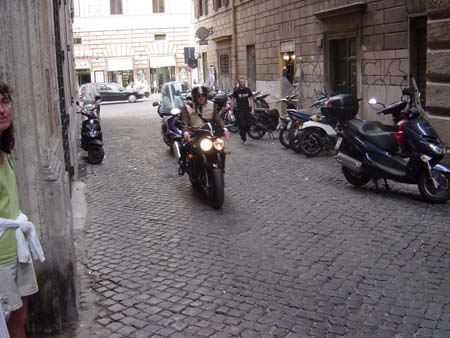
A striking characteristic of Rome is the difference between the main streets
and the side streets. The main streets are loud and very busy, with everyone
apparently in a rush to get somewhere. However, as soon as we turn onto a
side street, we feel like we're in a small alley. These "alleys"
are lined with all kinds of interesting shops, restaurants and gelaterias,
and they are great fun to explore. They're also a very easy place to get lost,
and unfortunately our map doesn't have many of them listed (or they're abbreviated
down to an 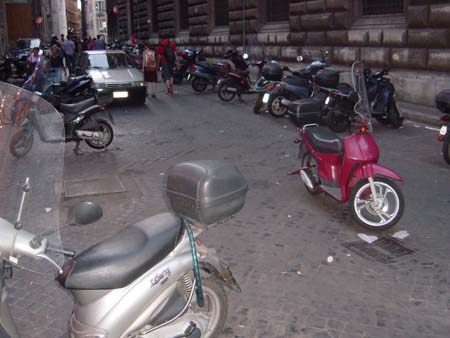 unintelligible
level). We found that the best way to get around is to wander in a general
direction, and wait until we hit a major street. At first this was frustrating,
but now it's actually kind of fun.
unintelligible
level). We found that the best way to get around is to wander in a general
direction, and wait until we hit a major street. At first this was frustrating,
but now it's actually kind of fun.
Speaking of the alleys, they can be hazardous as well. The motorcycles (we
guess they call them scooters, but to us they're motorcycles) are everywhere,
and are particularly dangerous on the side streets. We don't remember it being
like this in 1982 - these guys really rule the road. We did a couple of non-scientific
studies today, and there are definitely more cycles than cars. They are ridden
by everyone - businessmen in suits, women in dresses and high heels, punks,
etc. It's funny to watch what happens at a red light. Literally every cycle
weaves its way to the front of the line - there are always a group of 5-10
cycles revving their engines in front while they're waiting for the light
to turn. The cycles also constantly cut off the pedestrians - much more so
than the cars that actually tend to at least yield to pedestrians in cross
walks.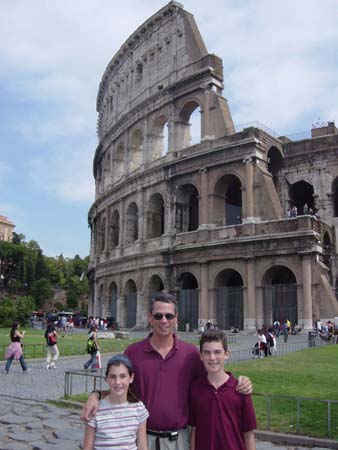
We took it easy this morning, spending time catching up on our reading and
writing (Yesterday, I received an accusatory e-mail insinuating that I was
lazy for not updating the web site at night before we went to bed!). We set
out in search of pizza before a tour that we had scheduled for 2:00. We had
no problem devouring four pizzas, with David and Katie continually again asking:
"How do they make it like this?" The crust and sauce that is used
here is fantastic and unlike anything at home.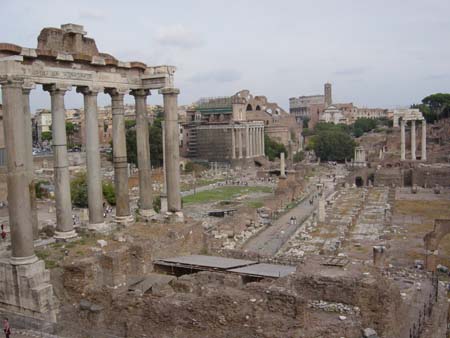
We walked to the Roman Colosseum for our scheduled tour. The guide was originally
an actor (struggling, we presume) from Connecticut, moved to Rome six years
ago and has no plans to return. With his theatrical background, he made the
tour of the Colosseum and Roman Forum entertaining as well as educational.
Paula and I did not use a guide when we came here in 1982 (we don't think
we were able to afford it…), and believe that this may be why our memories
of the Colosseum and Forum are so sketchy. For the culmination of the tour,
our guide used his theatrical abilities to re-enact the speeches that Mark
Antony and Brutus made (from right where we were standing) to thousands of
Romans in the Forum following the assassination of Julius Caesar. He did a
great job of setting the stage, and it was fun to imagine what the Forum was
like when this really happened.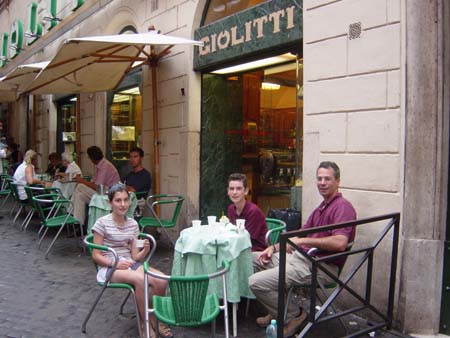
After the tour, we began to wander through the city, with the goal of finding
gelati at Gelateria Giolitti on our way up to the Spanish Steps. Along the
way, we made several stops at Piazza del Campidoglio (on Capitoline Hill and
the site of Rome's municipal government), Piazza del Parlimento (the Italian
Parliament), and Piazza Venezia. The gelati was a huge hit - they even had
"Menthe", our favorite flavor! The Spanish Steps  were
packed with people, and we enjoyed sitting on the steps and watching the tourists
and locals who were gathered. After climbing to the top and taking in the
view of Rome (dominated by St. Peter's), we strolled down Via Condotti, Rome's
most upscale shopping street. It was fun to look in the windows at the Gucci,
Prada, Ferragamo, and Cartier stores. We decided not to buy any of the 1,000
Euro handbags or 450 Euro pairs of gloves - perhaps we'll change our minds
and go back tomorrow.
were
packed with people, and we enjoyed sitting on the steps and watching the tourists
and locals who were gathered. After climbing to the top and taking in the
view of Rome (dominated by St. Peter's), we strolled down Via Condotti, Rome's
most upscale shopping street. It was fun to look in the windows at the Gucci,
Prada, Ferragamo, and Cartier stores. We decided not to buy any of the 1,000
Euro handbags or 450 Euro pairs of gloves - perhaps we'll change our minds
and go back tomorrow.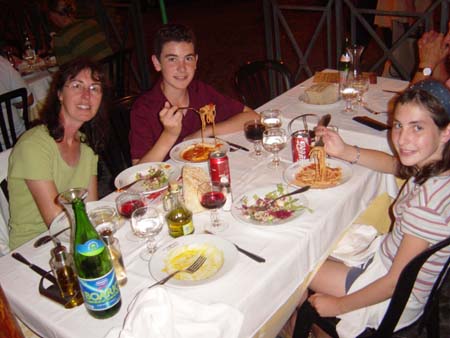
Finally, we returned to the Campo de Fiori for a fantastic dinner at La Carbonara. Paula and I enjoyed a couple of new pasta dishes, but David and Katie simply won't stray from the basic "Spaghetti Pomodoro" (basic tomato sauce). They absolutely love the tomato sauce, and can't get enough. Katie keeps saying: "This sauce is so simple, but so wonderful - you guys HAVE to learn how to make this!"
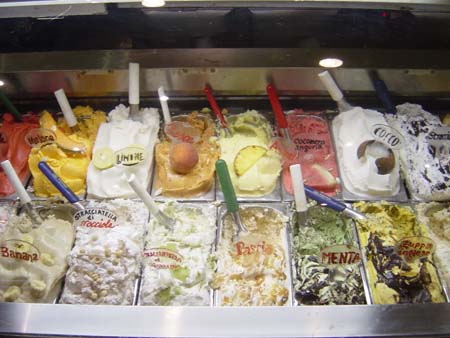 After
dinner, we walked through Piazza Navona - filled with artists and street performers
- and made our way to the Gelataria della Palma (our second trip for gelati
today!) and its 100 flavors of gelati (David counted 102). David and Katie
insisted on having large dishes, and had no problem at all finishing it all.
Gelataria della Palma is a neat place, described accurately in our book as
looking somewhat like Willy Wonka's factory. In addition to ice cream, they
sell all kinds of unique candies, including colorful candy flowers. It was
interesting to see how packed all the restaurants were as we walked on the
streets at 10:00 PM. Romans generally don't eat until 8:30 at the earliest,
and usually much later.
After
dinner, we walked through Piazza Navona - filled with artists and street performers
- and made our way to the Gelataria della Palma (our second trip for gelati
today!) and its 100 flavors of gelati (David counted 102). David and Katie
insisted on having large dishes, and had no problem at all finishing it all.
Gelataria della Palma is a neat place, described accurately in our book as
looking somewhat like Willy Wonka's factory. In addition to ice cream, they
sell all kinds of unique candies, including colorful candy flowers. It was
interesting to see how packed all the restaurants were as we walked on the
streets at 10:00 PM. Romans generally don't eat until 8:30 at the earliest,
and usually much later.
We splurged on a taxi ride back to the hotel, satisfied that we had done quite enough walking for the day. Tomorrow we plan to continue walking and exploring Rome, and are planning to make a day trip on Sunday to Ostia Antica.
Distance Walked: 5.33 miles
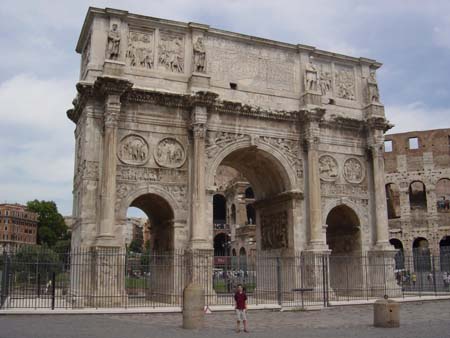
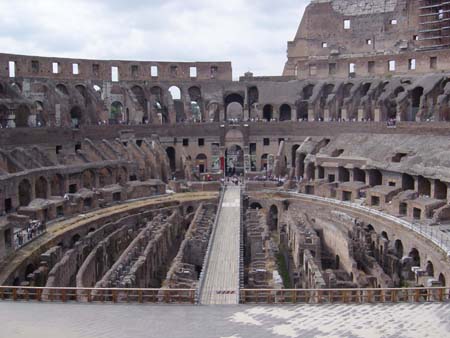
David's Download … The Olympics, Old and New
The modern Olympics have been a worldwide tradition since 1896. The Olympics
were originally created by the ancient Greeks around 776 B.C. Greek city-states
were called to gather at the ancient city of Olympia to pay tribute to Zeus.
There they competed in foot races, wrestling, boxing, etc. The modern Olympics
consist of the winter and summer games, which alternate every two years. The
location of the games is also changed each year. Although the modern Olympics
have many differences from the ancient games, they also have many similarities.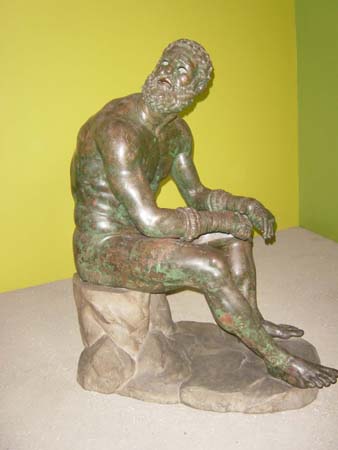
The ancient Greek Olympic Games were held in the summer every four years in Olympia. This site was chosen because of the great sanctuary of Zeus, where athletes paid their tributes before competing. The games were open to any honorable man of Greek descent. The first day of the games was devoted to festivity and sacrifices. The second day mainly consisted of foot races in the stadium, an area enclosed by banks of earth where spectators could look on. The next couple of days consisted of wrestling, boxing, and pancratium, a combination of the two. The objective of wrestling was to throw your opponent to the ground three times. Boxing became one of the fiercest sports in the ancient Olympics. At first, gloves were made of soft leather to lighten the blows, but later hard leather sometimes weighted with metal was used. That has got to hurt! Horse racing was also a popular sport. Only the rich could afford to take part in this sport because of the expensive horses (each participant had their own horse). The next event was the pentathlon, a series of five events. These events included wrestling, discus throwing, javelin hurling, long jumping, and sprinting. In the discus event a plate of bronze was thrown. In the javelin hurling event, competitors tried to throw a spear as far as possible. The winners in each event won a reef of olive leaves, fame, and living expenses for the rest of their lives. The ancient Olympics were at their peak in the fifth and fourth century B.C., until the Roman Emperor Theodosius I cancelled them. It was not until the late eighteen hundreds when they were revived and created into the modern Olympics.
The first modern Olympic Games were held in Athens in 1896. Two years before, a French educator named Pierre de Coubertin first introduced the idea to bring back the Olympics in hope of promoting a more peaceful world. The first modern Olympics consisted of only summer games and included 300 athletes from less than 15 countries, competing in 43 events in 9 different sports. It is astonishing to compare that to the 1996 Olympics, which included more than 10,000 athletes from 190 countries, competing in 271 events in 29 different sports! The 2004 summer Olympic Games will be held right in Athens. We saw the construction of the Olympic village and while we were there last week. We heard that they are way behind in construction and working overtime to finish it in time for next year! We also heard that they are 10,000 hotel rooms short, and are bringing in cruise ships for people to stay on.
During the opening ceremonies, many traditions are done to recognize the origin of the games. The torch is lit in Olympia, where the Olympics started, and carried by runners to wherever the games are that year. It sometimes takes months for them to achieve this task, but this year they are lucky. They only have to run a couple days from Olympia to Athens! The torch is lit by magnified sunlight in the ancient stadium. Another tradition is that the Greek team always walks out first during the opening parade of countries. After the parade, doves are released to symbolize world peace.
The Olympics have been an enjoyable tradition for the past 107 years, and hopefully will promote world peace. It has been fun learning and researching about the Olympic Games. It will be cool seeing the Games returning to Greece where they originated in 776 B.C.
